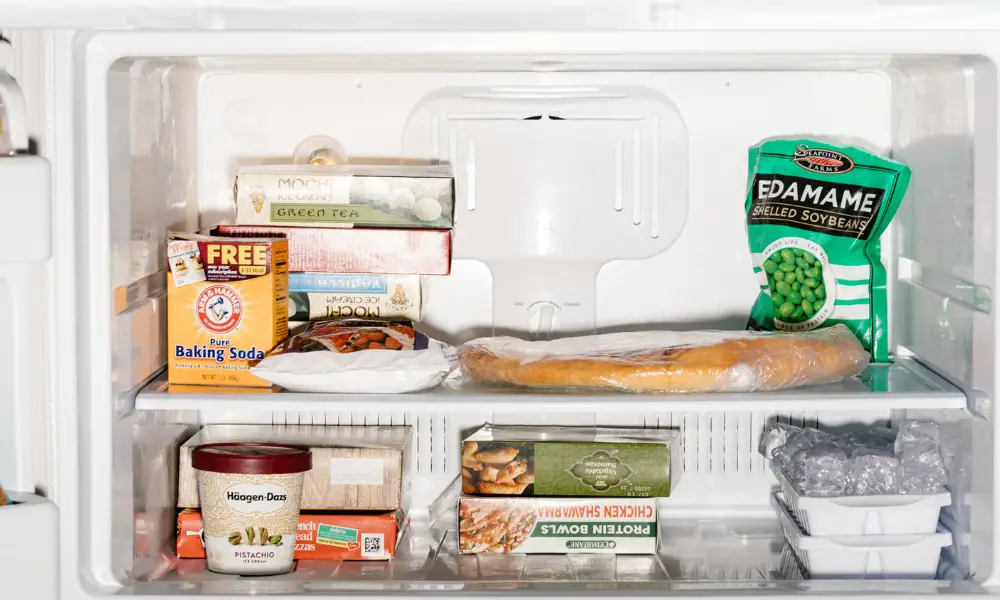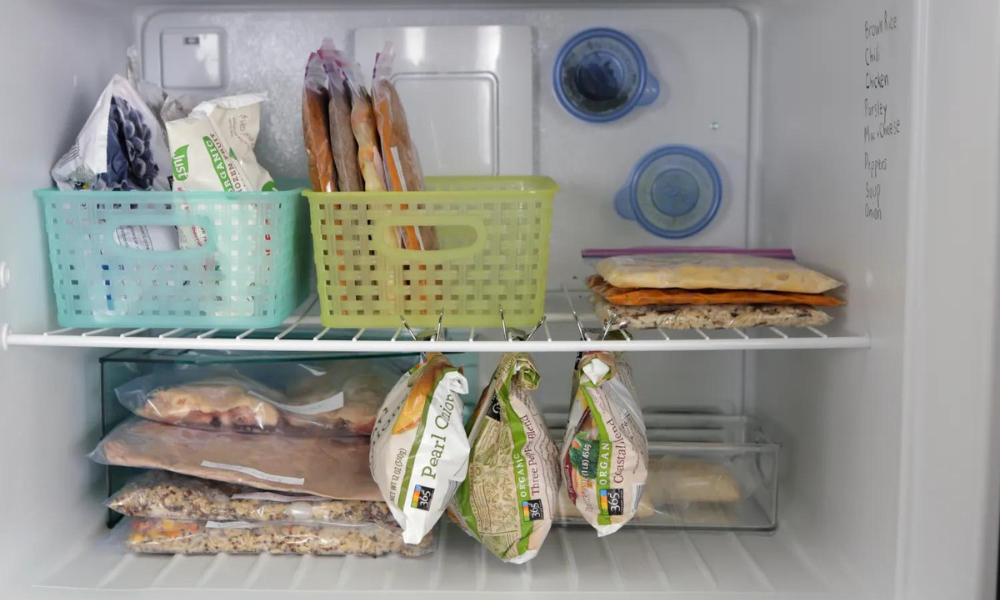Keeping food safe in your freezer is something that you should take into consideration. Not only will you want to ensure that the temperature in your freezer is just right, but you also want to ensure that you don’t have any bacteria or listeria growing in your freezer.
Keeping foods in the refrigerator at low temperatures can help prevent Listeria from growing. However, refrigerating food does not kill Listeria. This bacterial disease can be a serious illness, especially for those with weakened immune systems.

Keeping Food Safe in a Freezer
The following advice can help you keep food secure in a chest freezer:
- Keep the freezer at the right temperature: To keep food adequately frozen and safe to consume, a chest freezer should be kept at 0°F or lower.
- Use heavy-duty freezer bags or airtight containers to store food in the freezer—store food in airtight containers. Food will remain fresher for a longer period and help prevent freezer burn.
- Food should be labeled and dated so that you know how long it has been frozen and can use it before it spoils.
- Food should only be kept in the freezer for a short period since the longer it is kept there, the more quality it will lose. Within six to twelve months, try to use frozen food.
- Keep a list of what is in your chest freezer. This will allow you to organize your food and assist you in using up food that is about to spoil.
- Keep the freezer clean: By frequently cleaning the chest freezer, you can stop mold and bacteria growth.
- A chest freezer shouldn’t be overloaded because doing so can make it harder to maintain a constant temperature and accelerate food spoilage.
By considering these suggestions, you can help ensure that your food is safe and of high quality while being kept in a chest freezer. Keep in mind that if the power goes out, you should keep the freezer as much of the time closed as you can, add ice packs or bags of ice, and attempt to limit the number of times you open it.
Why is it Necessary to Keep Food Safe in the Freezer?
Food storage in the freezer is essential for several reasons:
- Food can become contaminated with bacteria like Salmonella, E. coli, and Listeria when it is not stored correctly in the freezer, leading to food illness. The careful preservation of food in the freezer can stop the formation of these dangerous microorganisms.
- Food quality preservation: Freezing food can help keep its flavor, texture, and quality. However, improper freezer storage can result in food becoming freezer-burned or developing unpleasant aromas, which can reduce the quality of the food.
- To reduce food waste, properly storing food in the freezer can help to extend its shelf life, allowing you to utilize it before it spoils. Both money and food waste can be saved by doing this.
- To ensure food is secure to consume: Although a freezer can limit the growth of bacteria, food that has been thawed and then refrozen or stored at an inappropriate temperature may no longer be safe to eat. Food safety is improved by properly storing it in the freezer.
- Cross-contamination can occur when raw and cooked meals are kept in the same space, which can be avoided by properly storing food in the freezer.
You can ensure that food is healthy and high-quality while also preventing food waste by keeping it safe in the freezer. Additionally, it’s crucial to regularly check the temperature of your freezer and toss any food that has defrosted or gone bad.
How Long does Food Stay Safe in the Freezer?
Food safety in the freezer is influenced by the type of food, how it is packaged, and the freezer’s temperature.
The following broad recommendations describe how various long types of food can be kept frozen:
- Fish, chicken, and meat: For six to twelve months, raw meat, poultry, and fish can be kept in the freezer. Cooked meat, poultry, and fish can be kept for two to six months.
- Dairy items: Soft cheeses and sour cream should be consumed within four to six months, whereas hard cheeses can be kept for six to twelve months.
- Vegetables and fruits: Vegetables and fruits can be preserved for 8 to 12 months.
- Bread and baked goods: These items can be stored for three to six months.
- Remaining food: Remaining food can be kept for two to six months.
It’s crucial to remember that these are only general recommendations and that storage times may change based on the particular item and how it has been packaged. Food should be securely packaged in airtight containers or frozen bags, marked with the date it was stored, and used within the suggested storage duration to help keep it safe in the freezer.
Reference: Freezer Storage
Ideally, freezers should be kept at or below 0 degrees Fahrenheit. You can take a few extra steps in addition to lowering the thermostat to maintain a chilly freezer. The key to keeping cold is air flow, so make more shelf space and fewer goods in the freezer. As a result, the freezer’s air circulation will be improved, resulting in a deeper freeze. Food should not be near the back vent. Blocking this vent results in a warmer freezer and reduced airflow.
Can Bacteria Grow on Food in the Freezer?
Although it takes a lot longer for bacteria to grow on food in the freezer than at temperatures above zero, bacteria can still do so. Although freezing food is a good technique to preserve and stop the growth of dangerous bacteria, it doesn’t necessarily mean the bacteria will be eradicated.
If the temperature in the freezer is higher than 0°F, bacteria can live and even develop there. Additionally, bacteria contamination may occur if the food has been frozen, thawed, and then refrozen. Furthermore, if the food is not properly sealed and stored, it may pick up bacteria from the air or other foods in the freezer.
In order to prevent the growth of bacteria, it is crucial to maintain the freezer at 0°F or lower. To reduce the chance of contracting a food-borne disease, it’s also critical to adopt safe food-handling techniques, such as washing your hands before handling food, keeping cooked and uncooked food separate, and cooking food to the proper temperature.
Additionally, it’s crucial to routinely check your freezer and eliminate any food that appears spoiled or has an odd color, smell, or texture. Try to limit the number of times you open the freezer and add ice packs or bags of ice if the power goes out. Food that has been kept above 40°F for longer than two hours should be thrown out.
At What Temperature does Frozen Food Become Unsafe to Consume?
When frozen food is kept at temperatures above 0°F (or -18°C) for an extended period, it becomes dangerous to consume. Bacteria and other microbes may start to grow and reproduce at these temperatures, perhaps leading to food-borne disease.
To keep frozen food safe to eat, the United States Department of Agriculture (USDA) advises keeping it at a temperature of 0°F or lower. When a freezer’s temperature exceeds this, the food within may start to defrost and become hazardous to consume. This may occur if the freezer develops a problem or the door is left ajar for a long time.
Additionally, it’s crucial to remember that food that has been thawed and then refrozen is more likely to be poisonous. Food poisoning is more likely to occur if taken after thawing because germs might start to thrive and reproduce in the thawed food. Food that has been thawed should be cooked and eaten within two days, or it can be refrozen if it hasn’t been out of the freezer for more than two hours.
It’s also crucial to regularly check your freezer’s temperature and eliminate any food that has defrosted or gone bad. Food should be thrown away if it has been kept at temperatures exceeding 40°F for longer than two hours.
How to Identify Whether Food in the Freezer is Spoiled?
Some of the signs of spoiled food include:
- Ice crystals: Large ice crystals on frozen food may indicate that it has been refrozen after being partially thawed, which can degrade its flavor and nutritional value.
- Discoloration or off-odors: If you observe any discoloration or off-odors on the food, it is probably rotten and needs to be thrown away.
- Food with freezer burn appears dried out, discolored, and leathery in texture. Although the quality and taste may be compromised, it is still safe to eat.
- Expiration date: Always check the food’s package for the expiration date; if it has passed, the food should be thrown away.
- Cans that are swollen or leaking: Food in cans that have gone rotten may do so. This indicates that the can is destroyed or the food inside has been ruined.
You should routinely check your freezer and throw away any food that appears to be spoiled. By doing this, you can guard against food poisoning and guarantee that you’re only eating wholesome foods. Remember to add ice packs or bags of ice to the freezer, keep it covered as much as possible, and limit the number of times you open the freezer if the power goes out.
Side Effects of Consuming Spoiled Food from the Freezer
Consuming damaged food from the freezer can have some negative impacts, such as:
- Food poisoning: Food tainted by hazardous germs like Salmonella, E. coli, or Listeria may result in food poisoning. Food poisoning signs and symptoms include nausea, vomiting, diarrhea, and fever.
- Certain forms of damaged food, including shellfish or nuts, may cause allergic reactions in some people. Hives, itching, swelling, and breathing difficulties are all indications of an allergic reaction.
- Toxins: Some forms of rotten food, such as mushrooms and some varieties of fish, may contain toxins that, if taken, might result in major health issues.
- Abdominal pains, bloating, and diarrhea are just a few gastrointestinal problems resulting from eating rotten food.
It’s crucial to understand that these consequences apply to eating food that has gone bad, not only food that has been frozen. When power is restored, always check your freezer’s temperature and throw away any food that has defrosted or gone bad. To reduce the danger of foodborne illness, it’s also crucial to constantly use excellent food handling techniques, such as washing your hands before handling food, keeping cooked and raw foods apart, and preparing food to the proper temperature.
Conclusion
Various microorganisms grow quickly in the temperature danger zone. These organisms can cause foodborne illnesses. Keeping food safe in a freezer is a must to avoid getting sick.
The best time to freeze food is 0 deg. This temperature is not only the ideal temperature for freezing but also slows down bacteria growth. If your freezer does not reach this temperature, you may need to add dry ice.

